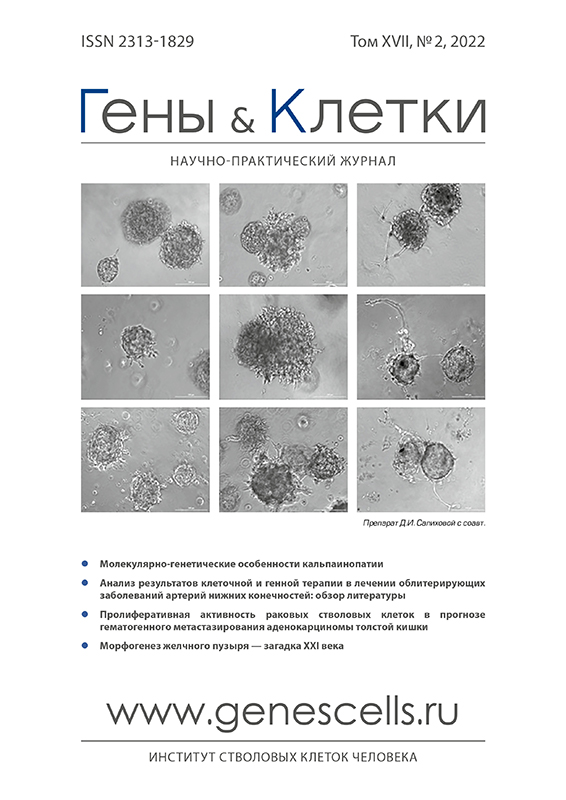Dynamics of inflammatory infiltrate in mice liver under conditions of experimental fecal peritonitis
- Authors: Safronova G.M.1, Indeikin F.A.1, Andreev Y.A.1, Emelin A.M.1, Presnyakov E.V.2, Deev R.V.1,2
-
Affiliations:
- I.I. Mechnikov North-Western State Medical University
- Histograft LLC
- Issue: Vol 17, No 2 (2022)
- Pages: 64-66
- Section: Original Study Articles
- Submitted: 25.01.2023
- Accepted: 25.01.2023
- Published: 25.09.2022
- URL: https://genescells.ru/2313-1829/article/view/133724
- DOI: https://doi.org/10.23868/202209011
- ID: 133724
Cite item
Abstract
The relationship between the liver and the peritoneum is an important element in a body homeostasis maintaining. Morphofunctional changes occurring in the liver in response to fecal peritonitis allow a better understanding of this relationship. Despite the existing researches, some aspects of the pathological changes occurring in the liver in fecal peritonitis require a special study.
Purpose: to describe the composition and dynamics of the lymphocytic-leukocytic infiltrate in the liver in conditions of experimental fecal peritonitis.
The study was conducted on Balb/c (n=5) mice with artificially induced fecal peritonitis. One animal was euthanized on 1, 3, 5, 7 and 14 day of the experiment. Immunophenotyping of inflammatory infiltrate cells was performed on liver tissue samples using antibodies to CD3, CD45, CD163. Morphometric analysis was carried out with the calculation of the number of cells per unit area.
It was shown that the highest intensity of infiltration by CD45+-cells is observed on the 3rd day of the experiment with a subsequent decrease; infiltration by CD3+-cells increases by the 5th day of the experiment without further dynamics; infiltration of CD163+-cells — by day 7 without further changes.
Conclusions: the severity of the liver parenchyma infiltration by immune cells in dynamics reflects the organ reaction to experimental fecal peritonitis.
Keywords
Full Text
About the authors
G. M. Safronova
I.I. Mechnikov North-Western State Medical University
Author for correspondence.
Email: f.indeickin@yandex.ru
Russian Federation, St. Petersburg
F. A. Indeikin
I.I. Mechnikov North-Western State Medical University
Email: f.indeickin@yandex.ru
Russian Federation, St. Petersburg
Yu. A. Andreev
I.I. Mechnikov North-Western State Medical University
Email: f.indeickin@yandex.ru
Russian Federation, St. Petersburg
A. M. Emelin
I.I. Mechnikov North-Western State Medical University
Email: f.indeickin@yandex.ru
Russian Federation, St. Petersburg
E. V. Presnyakov
Histograft LLC
Email: f.indeickin@yandex.ru
Russian Federation, Moscow
R. V. Deev
I.I. Mechnikov North-Western State Medical University; Histograft LLC
Email: f.indeickin@yandex.ru
Russian Federation, St. Petersburg; Moscow
References
- Луцевич О.Э., Акимов В.П., Ширинский В.Г. и др. Вопросы патогенеза спаечной болезни брюшины и современные подходы к ее предупреждению. Московский хирургический журнал 2017; 3: 11–26. [Lutsevich O.E., Akimov V.P., Shirinsky V.G. et al. Some pathogenesis aspects of peritoneal adhesion formation and modern approaches to its prevention. Moscow Surgical J. 2017; 3: 11–26].
- Буянов В.М., Родоман Г.В., Белоус Г.Г. и др. Экспериментальная модель острого гнойного перитонита. Хирургия 1997; 1: 25–8 [Buyanov V.M., Rodoman G.V., Belous G.G. et al. Experimental model of acute purulent peritonitis. Surgery 1997; 1: 25–8].
- Федоров Н.А., Матвеев Д.В., Каралкин А.В. и др. Фибронектин крови и фагоцитарная функция печени у больных перитонитом. Вестник хирургии 1995; 154(1): 12–7 [Fedorov N.A., Matveev D.V., Karalkin A.V. et al. Blood fibronectin and phagocytic function of the liver in patients with peritonitis. Bulletin of Surgery 1995; 154(4): 12–7].
- Gadelha D.N.B., Melo M.C.S.C., Oliveria T.K.B. et al. Autogenous fecal peritonitis in Wistar rats with permanent bilateral carotid occlusion: morbidity, mortality and microbiological response. Acta Cir. Bras. 2013; 28: 299–306.
- Garrido A.G., Figueiredo L.F.P., Silva M.R. Experimental models of sepsis and septic shock: an overview. Acta Cir. Bras. 2004; 19: 82–8.
- Brocco M.C., Gomez R.S., Paulo D.N.S et al. Histological features of peritoneal lavage with ropivacaine in rats with fecal peritonitis. Acta Cir. Bras. 2012; 27: 193–9.
- Brocco M.C., Paulo D.N.S., Baptista J.F.A. et al. Effects of peritoneal lavage with lidocaine on survival of rats with fecal peritonitis. ActaCir. Bras. 2008; 23: 42–7.
- Ельчанинов А.В. Молекулярные и клеточные механизмы регенерации печени после субтотальной резекции в эксперименте [диссертация]. Москва: ФГБНУ «Научно-исследовательский институт морфологии человека»; 2017. [Elchaninov A.V. Molecular and cell mechanisms of liver regeneration after subtotal resection in experiment [dissertation]. Moscow: Federal State Scientific Institution (FGBNU NIIMCH); 2017].
- Lutz P., Jeffery H.C., Jones N. et al. NK Cells in Ascites From Liver Disease Patients Display a Particular Phenotype and Take Part in Antibacterial Immune Response. Front. Immunol. 2019; 10: 1838.
Supplementary files











